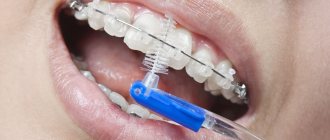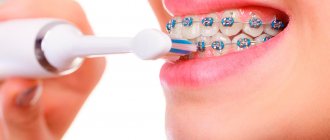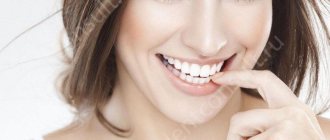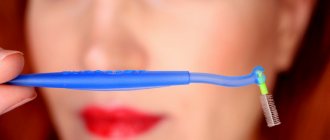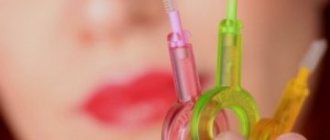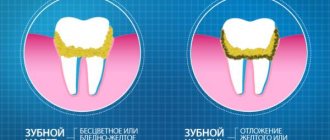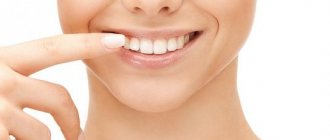While wearing braces, careful oral care is necessary .
For these purposes, various means are provided (special brushes, dental floss, irrigators, etc.).
And one of such effective devices is brushes for braces .
They are designed to clean the interdental space and braces from stuck food particles.
Also, brushes have a massaging function and, thereby, prevent bleeding gums.
For your information! Today they are produced in a wide variety (in size and shape) and everyone can choose the option that suits personal preferences and certain needs.
Why do you need to use special brushes for cleaning with braces?
It is worth using brushes for cleaning, because they are able to eliminate even the smallest particles of food , which inevitably remain in the interdental space and in the braces themselves .
Ordinary this 100% .
As a result, colonies of pathogenic microorganisms form in the oral cavity, subsequently leading to the initial stage of caries and other adverse consequences.
Keep in mind! Regular use of these brushes helps keep your teeth clean and healthy.
At the same time, the brace system used retains a well-groomed appearance longer.
How to properly clean braces with a brush
You should take the purchase of the product seriously. It is chosen taking into account personal characteristics and parameters of the oral cavity. If the bristles are not long enough, they will not completely remove plaque and food particles. If, on the contrary, it is excessively high, then it can damage the gums and provoke the correction clasps to come off. When purchasing, pay attention to the thickness of the fibers. They must freely penetrate to all desired areas.
What happens if you don't use it?
If you do not use special brushes for cleaning, then in the future there may be such negative consequences as:
- Formation of tartar (due to the accumulation of plaque in hard-to-clean places).
- Darkening and thinning of tooth enamel.
- The emergence and development of caries.
- Darkening of the metal arches of the bracket system itself.
To avoid various risks, it is recommended to use such brushes regularly. Otherwise, the method does not guarantee 100% results.
At what age can a dental brush be used?
You can allow your child to use a dental brush as soon as he begins to understand the essence of the procedure. The baby should clean the interdental spaces with this device on his own, but care must be taken that it does not damage the teeth or gums. Before purchasing a dental appliance, you should consult your dentist.
If you choose the right dental brushes and use them wisely, you can improve the quality of your oral hygiene. But in no case should these devices replace a brush with toothpaste, dental floss and mouth rinse.
Types of devices
You should know! Orthodontic brushes are classified according to several criteria. So, the following varieties are distinguished:
- By bristle hardness : soft, medium and hard. Patients with hypersensitive teeth are recommended to use brushes with soft bristles.
- The shape of the bristles : cylindrical, curved and conical. Cylindrical bristles have the same length over the entire surface of the rod and are intended not only for braces, but also for cleaning wide interdental spaces and caring for gums. Curved - the most expensive option, in which the rod and handle have a semicircular shape. This type of device is considered the most effective means of cleaning braces. Conical, in turn, have cone-shaped bristles (the longest bristles are located at the base, and the shortest at the top). They can be used for daily cleaning of braces and teeth.
- Handle length : short and long. In this case, experts advise focusing solely on your preferences (what length of handle will be most comfortable to hold).
- By size of interdental spaces : small, medium and wide. In this case, the size is selected by the hygienist (after measuring the interdental space).
- By length of the bristles : with short and long bristles. The length of the short bristles is 1 mm and is used for cleaning narrow lateral edges, the long bristles are 3 mm, indicated for wide interdental spaces.
- By product length : there are sizes XS, S, M, L and XL in increasing order (accordingly, size XL is the largest).
- Operating principle : manual and electric. The second option is considered more effective in terms of cleaning braces and tooth enamel from plaque and food debris.
It is worth noting! A dentist or hygienist will help you choose the best brush option.
After all, convenience and comfort during the cleaning process is the key to a healthy and beautiful smile.
What is a toothbrush?
For reference! The appearance of such a product for the oral cavity is similar to a regular brush used for cleaning glass containers, but its size is several times smaller.
two components in this device :
- pen;
- The product itself is a brush, which is used to clean the surface between the teeth.
The length of the bristly rod reaches several centimeters.
Its basis is a steel wire on which synthetic bristles are attached.
They are most often made from nylon, although other synthetic materials are also used.
The rod is additionally covered with plastic. This was done to prevent the occurrence of static discharges during use of the device.
Note! The materials used in the manufacturing process of these products are always environmentally friendly, durable and inert.
Thus, they do not enter into oxidation processes upon contact with saliva during the procedure.
Depending on the manufacturer, these devices are available both as attachments and as a one-piece design. The first ones come with special holders.
How to choose the right one?
When choosing a suitable device, you must consider the following important nuances :
- Length of bristles - if the teeth fit tightly together, then it is better to choose a product with short bristles. If there are small gaps between the teeth, then a product with long bristles would be an ideal option.
- Brush length - small sizes are suitable for children, larger sizes for adults (L, XL).
- Bristle hardness - dentists advise choosing products with medium bristle hardness. But people with sensitive or damaged enamel should give preference to soft brushes.
- The length of the handle of the product should be based on personal considerations of comfort during cleaning. Some people find it convenient to hold a product with a short handle, others with a long handle.
- Product quality - it is advisable to choose products from well-known brands, after studying consumer reviews.
According to dentists, the most convenient to use are cone-shaped brushes.
They not only effectively clean braces, but also interdental spaces, eliminating plaque and bacteria accumulation.
Selection rules
When purchasing a brush, you should pay attention to the following parameters:
- The length of the device itself .
There are 5 sizes available, and the optimal length is selected based on age. Thus, for children, a product with the shortest working part (designated S) is recommended. The maximum size is designated XL. Advice: it is very difficult to determine on your own exactly how long a brush is required. It is best to do this together with a doctor: after measuring the interdental distance, he will determine the desired size. - Villi length . Here you should focus on the size of the interdental space. Thus, for crowded units, it is recommended to use models with short villi (1 mm), and for trema and diastemas - with a length of 3 mm or more. It is also necessary to take into account the presence of orthodontic structures, implants and dentures. Products with short bristles are best for cleaning.
- Villi hardness . The devices are available with 2 types of bristles: soft and medium hard. Soft ones are approved for use for children, for periodontal hypersensitivity and for cleaning implants.
- The material from which the rod for attaching the bristles is made. Plastic or metal is used to make it. For weak and inflamed periodontal tissue, dentists recommend a brush with a plastic rod, since it is elastic and does not injure the mucous membrane and soft tissues.
- Handle length . This parameter is associated with the individual preferences of patients, i.e. whoever is more comfortable. Many manufacturers add stops, protrusions and rings to the handle, making it more comfortable.
Tip: a device with a smooth handle is difficult to hold in your hand when cleaning, so it is better to give preference to models with protrusions or stops on the handle.
We must not forget about quality. Your choice should be made on products from well-known global manufacturers who have proven themselves to be positive over the years.
General tips for use
Stay up to date! Using these products is quite simple. However, it is necessary to take into account a number of the following rules:
- Before using the brush, be sure to brush your teeth in the usual way (using toothpaste and a regular brush).
- Bring the device to the interdental spaces (hold the device perpendicular) and gently massage the required areas of the teeth and the brace system (especially metal arches).
- It is advisable clean after every meal .
- After each use, the brush must be rinsed with warm water and then closed with a cap (included in the kit).
- Carry out the procedure without using special cleaning products (paste or tooth powder).
- Change the product as often as possible (if the fibers lose stiffness), on average once every 2-4 weeks .
In the first days of using the brush, the gums may bleed a little , which is quite normal for the adaptation period.
Remember ! However, if such symptoms persist for a week and your teeth hurt, you should consult a doctor for advice.
General rules for caring for braces
If you want to maintain healthy teeth, you must follow the general rules for caring for braces. Let's describe them briefly:
- For braces, special toothbrushes are used that allow you to clean the enamel and all elements of the orthodontic structure.
- Treatment of the oral cavity should be performed 4-5 times a day or more often (after all meals, as well as in the morning and evening).
- It is necessary to clean not only the teeth themselves, but also all accessible surfaces of the braces.
- It is advisable to buy toothpaste with a high content of fluoride and calcium to increase the protective properties of the enamel. For the paste to be effective, it is recommended to regularly change it to a product from another company, since the enamel gets used to a certain composition and stops reacting to it.
- If you cannot clean some places, you should resort to the help of additional devices: dental floss, special brushes, etc.
- If you use rinse aid, do not use regular brands, but only ones that do not contain alcohol or dyes.
The main task of caring for the oral cavity while wearing braces is to preserve the enamel. This can be done in different ways. Read for interest what scientists are offering today: Scientists have found a way to protect tooth enamel in cancer patients.
Sequence of application
the cleaning device as follows:
- Rinse the product under running water.
- the brush one by one into the interdental spaces and, using soft circular movements, clean the enamel surface with a regular brush . Do not move up and down (like dental floss). Do not touch the incisors.
- Then place the bristles of the product between the arch of the bracket system and the enamel . Make light movements (clockwise).
- Rinse the brush with warm water and close the cap. Remove until next use.
Remember! To maintain oral hygiene, you can also use special rinses, for example, Listerine, etc.
They will help cope with plaque and prevent caries.
What is a dental brush for?
People use a baby bottle brush when they need to remove milk residues that could not be removed with regular water. The situation is similar with dental brushes. They are used if necessary:
- remove pieces of food from the interdental spaces that cannot be rinsed with water or removed with a regular toothbrush;
- clean the back surface of the teeth;
- ensure better oral hygiene.
There are a number of medical indications for which it is necessary to use a dental brush:
- wearing braces;
- presence of dental prostheses or implants in the mouth;
- periodontal pathology;
- a large number of diastemas and three;
- crowded teeth and their irregular shape;
- smoking and frequent consumption of coloring products;
- chronic diseases that, even in a vegetative state, have a bad effect on the microflora of the oral cavity.
Popular manufacturers
Today, many manufacturers produce special brushes for cleaning braces, but not all of them are of high quality.
So, the most effective products are from the following brands :
- Lacalut (lacalut) - products are equipped with a metal rod made of hypoallergenic materials, covered with insulating plastic. This reduces trauma during use. Average price: 300 rubles and above.
- Colgate Total (colgate) – a distinctive feature of this product is that the products are produced in a set, which includes brushes with different bristle lengths. The cost of the product is on average 250-270 rubles.
- Miradent - are available in the form of a set that includes 4 brushes with ultra-soft bristles and a wire rod. The products differ from each other in the length and thickness of the bristles, as well as the diameter of the rod. The cost of the set is 500 rubles.
- Oral-B (oral bi) – products are cylindrical and cone-shaped, sold in small containers (include 1 pc.). Also available in sets. The price ranges from 250 to 400 rubles.
- Curaprox (curaprox) - products are made from a special alloy that is used in the surgical industry. The brushes produced under this brand are of high quality and have a long service life. Therefore, they cost around 1000 rubles.
Products from the above brands are not only highly effective, but also absolutely safe to use.
Features of different brands
Despite the fact that the design and appearance of these orthodontic products are mostly the same, there are some differences depending on the manufacturer .
Below are the distinctive features of brushes for cleaning teeth from different brands.
Colgate
There are various products in both shape and size . They are equipped with a comfortable handle.
The cross-section of the bristles is triangular, making cleaning quick and efficient .
The diameter of the tip varies and ranges from 2 to 5 mm.
Lacalut
Need to know! The teeth cleaning device is made using a special surgical alloy and plastic coating.
Additionally, in the kit .
It can be used as a handle extension.
Oral bi (Oral-b)
Conical and cylindrical products with a special holder.
The set includes a special container for storing the device.
Curaprox
They produce products of various models and purposes.
For your information! There are those that are suitable for daily and regular use, for cleaning orthodontic structures, dentures or implants.
The length of the bristles varies between 2.2-5 mm.
What is an electric brush for braces?
An electric brush is a device for cleaning braces and interdental spaces .
The bristles of the product vibrate due to the built-in electric motor.
Power comes from either a battery or a rechargeable battery.
Using this brush allows you to quickly and easily clean braces and tooth enamel from plaque and stuck food debris .
Therefore, this type of brushes is becoming increasingly popular.
Review of the best orthodontic brush models
You may be confused by the huge selection of orthodontic toothbrushes, so we will help you make your choice by presenting a brief overview of the most popular models:
- Vitis Orthodontic has a V-shaped bristle, as well as a special reinforced projection consisting of elongated bristles - for improved cleaning quality. The bristles themselves have varying degrees of hardness, so they can be used to combine types of care - cleansing and gentle gum care. This line features brushes of different sizes, so you can choose a model for each family member, including children. The cost is approximately 250 rubles.
- Miradent I-Prox is a mono-beam brush. The system allows you to change attachments and store them in a special compartment in the brush handle. Thanks to its special pointed shape, the brush effectively allows you to clean the most inaccessible places and interdental spaces, and cleans your teeth from two different angles. This brush will cost you about 370 rubles.
- Oral-B Electric Brush. This does not mean the brush itself, but a set of three replaceable attachments for it - OD-17. Thanks to the fastening system, they fit all Oral-B electric brushes and are designed specifically for cleaning braces. The cost of the set is approximately 700 rubles.
- Panasonic EW-DS 11 K 520 is also an electric brush. It has a rectangular head and bristles made from a material specially designed for effective cleaning. Unlike the previous system, Panasonic makes not circular, but pulsating movements at great speed, which is preferable for the design of the system. The cost of the device is more than 1000 rubles.
vote
Article rating
Useful video
From this video you will learn how to properly care for braces:
Brushes for cleaning braces are an important element of complete oral care. They provide excellent protection of the enamel and bracket system from plaque and pathogenic bacteria .
At the same time, they are easy to use. With their help, you can not only protect yourself from problems such as caries and tartar, but also extend the life of the product.
The most important thing is to make the right choice by first studying the characteristics of a particular brush. Then convenience and comfort during the cleaning process are ensured.
Why are such interdental products needed?
The purpose of these interdental products is to remove dirt between teeth and in hard-to-reach places (in the case of installed braces).
Thanks to high-quality cleaning of the dental cavity using a brush, the risk of caries and periodontal disease is reduced, bad breath and bleeding gums are eliminated .
The lateral surface of the teeth makes up 40% of the entire dental surface.
It is difficult to clean dirt from these areas with a regular brush, but it is between the teeth that putrefactive bacteria develop most actively.

